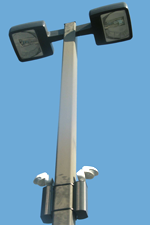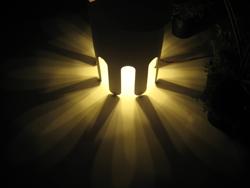 Even after daytime users drive home, parking lots and garages light up the night. Evening users are few, but for safety reasons, the lights stay on.
Even after daytime users drive home, parking lots and garages light up the night. Evening users are few, but for safety reasons, the lights stay on.
Yesterday, the California Lighting Technology Center at UC Davis debuted an innovative, highly efficient, greener way to park cars that additionally provides more safety for students and motorists using parking garages.
Michael Siminovitch, director of the school’s lighting-center and a professor in the Design Program, saw all that wasted light and knew there had to be a better way.
The innovative result, unveiled in a UC Davis parking garage after two years of development and field testing, is a highly efficient greener way to park cars.
The system uses about 20 percent of the energy of conventional parking lighting systems, yet provides better safety, reduces light pollution and makes less toxic waste.
This bi-level lighting, part of UC Davis’ Smart Lighting Initiative, is already serving six UC Davis sites (three parking areas, one pathway network and two building exteriors), as well as Sacramento State University and Arcade Creek Park in Sacramento.
 The safety feature uses motion detectors to alert people of nearby movement. The lights in the garage switch from low brightness to high signaling to people using the garage that there is another car or person moving nearby — and transmits that information to security personnel, as well. (Photo: LED fixture created by lighting design student)
The safety feature uses motion detectors to alert people of nearby movement. The lights in the garage switch from low brightness to high signaling to people using the garage that there is another car or person moving nearby — and transmits that information to security personnel, as well. (Photo: LED fixture created by lighting design student)
Impressed with the economy and safety of the greener garage, other Universities are adopting the design, including UC Santa Barbara; Cal Poly San Luis Obispo; Tianjin Polytechnic University in China; University of Notre Dame; North Carolina State University; and University of Arkansas.
The new system includes LED fixtures and motion sensors:
- Light-emitting diode (LED) lights give off bright white light but use little electricity. Each lighting fixture, called a luminaire, has three light bars containing 60 LEDs. Compared to conventional metal-halide lights, LED lights take less electricity (85 watts vs. 175 watts), last longer and contain no mercury.
- Motion sensors detect the motion of a person or vehicle within about 35 feet. When no motion is detected for a designated period of time (30 seconds to 30 minutes), the sensor switches the LED light from its high level to a low level that uses half the energy. Even low level is bright enough to provide plenty of light for people entering the garage.
“Switching to LED lights and adding bi-level activity-sensing technology yields energy savings for the project of 50 percent when the lights are at full power and 80 percent when they are in low mode. As for maintenance savings, we project they will be 42 percent of what we spent on the fixtures that were replaced,” Siminovitch said. “Even at half power, the LED fixtures are delivering plenty of light to the space. We may be able to cut levels further, saving even more electricity and lengthening fixture lifetimes.”
The Smart Lighting Initiative is a collaboration with California energy regulators and providers, and a handful of key firms in the lighting industry:
– PG&E offered incentives as part of a University of California systemwide energy initiative and supplied partial funding based on demonstrated energy savings.
– Ruud Lighting/BetaLED of Sturtevant, Wisc. supplied the LED light fixtures; and
– Watt Stopper/Legrand of Santa Clara, Calif. supplied the occupancy sensors.
The California Lighting Technology Center is part of the Design Program at UC Davis. The center is a research and education facility that focuses on the application of energy-efficient lighting and daylighting technologies through research, development, demonstration, outreach, and education in partnership with utilities, manufacturers, end users, builders, designers and governmental agencies. The center was established through a collaborative effort of the California Energy Commission’s Public Interest Energy Research (PIER) Program and UC Davis, with support from the U.S. Department of Energy and the National Electrical Manufacturers Association.



















